上大历年翻译真题
历年大学英语四级翻译真题

历年大学英语四级翻译真题n Technology (IT) XXX and more n to it。
Some schools even make it a compulsory course。
People have different ns on this phenomenon。
Some think it is unnecessary and students should XXX that China should keep up with the times and embrace IT。
Regardless。
the fact that IT is receiving n from the general public is a good thing.As the n Technology industry rapidly develops。
many XXX increasing importanceXXX。
XXX it is unnecessary。
as students should focus on nal curriculum。
XXX it is necessary for China to keep up with the times。
heless。
it is a positive development that the public is XXX.XXX of whether to choose tea or coffee during meals is often asked of diners。
with many XXX while Chinese people tend to choose tea。
Legend has it that a Chinese emperor discovered tea 5000 years ago and used it for medicinal purposes。
2015年11月英语三级笔译真题及答案(大师兄版)
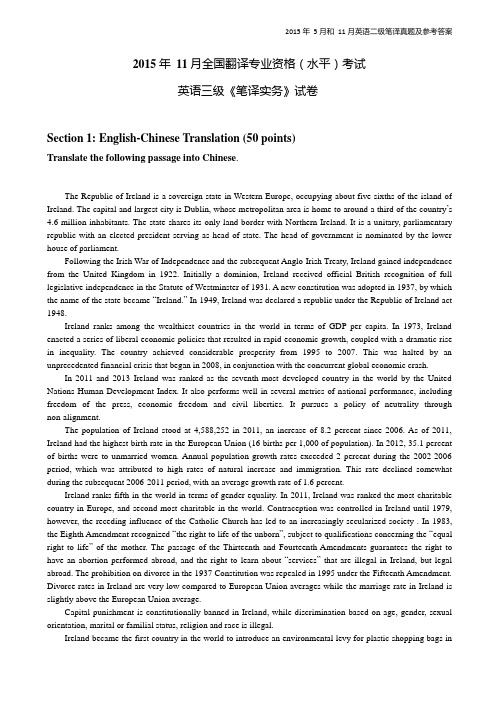
2015年11月全国翻译专业资格(水平)考试英语三级《笔译实务》试卷Section1:English-Chinese Translation(50points)Translate the following passage into Chinese.The Republic of Ireland is a sovereign state in Western Europe,occupying about five-sixths of the island of Ireland.The capital and largest city is Dublin,whose metropolitan area is home to around a third of the country’s 4.6million inhabitants.The state shares its only land border with Northern Ireland.It is a unitary,parliamentary republic with an elected president serving as head of state.The head of government is nominated by the lower house of parliament.Following the Irish War of Independence and the subsequent Anglo-Irish Treaty,Ireland gained independence from the United Kingdom in1922.Initially a dominion,Ireland received official British recognition of full legislative independence in the Statute of Westminster of1931.A new constitution was adopted in1937,by which the name of the state became“Ireland.”In1949,Ireland was declared a republic under the Republic of Ireland act 1948.Ireland ranks among the wealthiest countries in the world in terms of GDP per capita.In1973,Ireland enacted a series of liberal economic policies that resulted in rapid economic growth,coupled with a dramatic rise in inequality.The country achieved considerable prosperity from1995to2007.This was halted by an unprecedented financial crisis that began in2008,in conjunction with the concurrent global economic crash.In2011and2013Ireland was ranked as the seventh-most developed country in the world by the United Nations Human Development Index.It also performs well in several metrics of national performance,including freedom of the press,economic freedom and civil liberties.It pursues a policy of neutrality through non-alignment.The population of Ireland stood at4,588,252in2011,an increase of8.2percent since2006.As of2011, Ireland had the highest birth rate in the European Union(16births per1,000of population).In2012,35.1percent of births were to unmarried women.Annual population growth rates exceeded2percent during the2002-2006 period,which was attributed to high rates of natural increase and immigration.This rate declined somewhat during the subsequent2006-2011period,with an average growth rate of1.6percent.Ireland ranks fifth in the world in terms of gender equality.In2011,Ireland was ranked the most charitable country in Europe,and second most charitable in the world.Contraception was controlled in Ireland until1979, however,the receding influence of the Catholic Church has led to an increasingly secularized society.In1983, the Eighth Amendment recognized“the right to life of the unborn”,subject to qualifications concerning the“equal right to life”of the mother.The passage of the Thirteenth and Fourteenth Amendments guarantees the right to have an abortion performed abroad,and the right to learn about“services”that are illegal in Ireland,but legal abroad.The prohibition on divorce in the1937Constitution was repealed in1995under the Fifteenth Amendment. Divorce rates in Ireland are very low compared to European Union averages while the marriage rate in Ireland is slightly above the European Union average.Capital punishment is constitutionally banned in Ireland,while discrimination based on age,gender,sexual orientation,marital or familial status,religion and race is illegal.Ireland became the first country in the world to introduce an environmental levy for plastic shopping bags in2002and a public smoking ban in2004.Recycling in Ireland is carried out extensively and Ireland has the second highest rate of packaging recycling in the European Union.Section2:Chinese-English Translation(50points)Translate the following passage into English.冲突对抗,是构建中美新型大国关系的必要前提。
2016年11月英语三级笔译真题及答案大师兄翻硕版

2016年11月英语三级笔译真题及答案大师兄翻硕版2016年5月和11月CATTI英语二三级笔译真题及大师兄版参考译文答案及历年CATTI英语二三级笔译真题及答案由大师兄翻硕整理.2016年11月英语三级笔译真题汉译英节为“保利集团”简介.此份真题难度不大,与2015年及2014年的同类真题难度接近,详见配套解析讲义。
2016年11月英语二级笔译真题及2017年版历年CATTI英语二级笔译和三级笔译陆续上传.2016年11月全国翻译专业资格(水平)考试英语三级《笔译实务》试卷Section 1: English—Chinese Translation (50 points) Translate the following passage into Chinese.Harper Lee was an ordinary womanas stunned as anybody by the extraordinary success of “To Kill a Mockingbird.”“It was like being hit over thehead and knock ed cold,” Lee — who died Friday at age 89,saidduring a 1964 interview。
“I didn't expect the book to sell in the first place。
I was hoping for a quick and merciful death at the hands of reviewers but atthe same time I sort of hoped that maybe someone would like it enough to giveme encouragement。
"“To Kill a Mockingbird” may notbe the Great American Novel. But it’s likely the most universally known work offiction by an American author over the past 70 years. Lee was cited for hersubtle, graceful style and gift for explaining the world through a child's eye,but the secret to the novel’s ongoing appeal was also in how many books thissingle book contained。
英语翻译基础历年真题试卷汇编23

英语翻译基础历年真题试卷汇编23(总分:12.00,做题时间:90分钟)一、英汉互译(总题数:6,分数:12.00)1.汉译英(分数:2.00)__________________________________________________________________________________________ 解析:2.科学是讲求实际的。
科学是老老实实的学问,来不得半点虚假,需要付出艰巨的劳动。
同时,科学也需要创造,需要幻想。
有幻想才能打破传统的束缚,才能发展科学。
科学工作者不应当把幻想让诗人独占了。
嫦娥奔月、龙宫探宝、《封神演义》上的许多幻想,由于科学发展,今天大都变成了现实。
伟大的天文学家哥白尼说,人类的天职在于勇于探索真理。
我国人民历来是勇于探索,勇于创造,勇于革命的,我们一定要打破陈规,披荆斩棘,开拓我国科学发展的道路。
既异想天开,又实事求是,这是科学工作者特有的风格。
让我们在无穷的宇宙长河中去探索无穷的真理吧!(分数:2.00)__________________________________________________________________________________________ 正确答案:(正确答案: Science is practical learning, which tolerates no falseness and demands tremendous efforts. Meanwhile, it also demands creation and fantasy. Only fantasy can cut off the bound of the tradition and develop science. Do science work! Don"t let poets take advantage of fantasy alone. Via science, many fantasies in ancient China have come true. Such fantasies include, for example, the one in which the lady Chang"e who swallowed elixir stolen from her husband flew to the moon, the one in which Monkey Sun, the famous hero in one of the Chinese classic mythical novels, dove into the "dragon"s palace" in the deep water to search for treasures, and those described in The List of Conferred Gods, another Chinese classic mythical novel. The great astronomer Copernicus said man"s bounden duty lay in the bold seeking of truth. Chinese people have been bold in exploration, creation and revolution all through the ages. We must break with convention and chop a way through difficulties for the development of science in China. It is characteristic of science workers both to indulge in the wildest fantasy and seek truth from facts. Let"s seek the infinite truth in the boundless space!)解析:3.上海自贸区于2013年8月22日经国务院批准设立,9月29日正式挂牌。
历年大学英语四级翻译真题汇总(含参考范文)
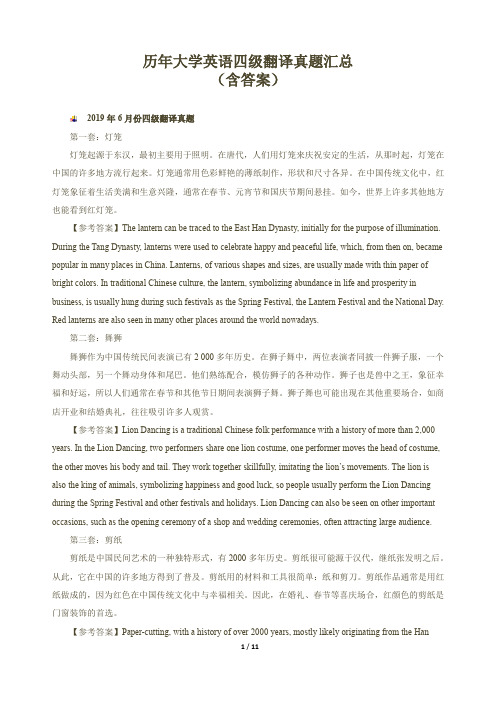
历年大学英语四级翻译真题汇总(含答案)2019年6月份四级翻译真题第一套:灯笼灯笼起源于东汉,最初主要用于照明。
在唐代,人们用灯笼来庆祝安定的生活,从那时起,灯笼在中国的许多地方流行起来。
灯笼通常用色彩鲜艳的薄纸制作,形状和尺寸各异。
在中国传统文化中,红灯笼象征着生活美满和生意兴隆,通常在春节、元宵节和国庆节期间悬挂。
如今,世界上许多其他地方也能看到红灯笼。
【参考答案】The lantern can be traced to the East Han Dynasty, initially for the purpose of illumination. During the Tang Dynasty, lanterns were used to celebrate happy and peaceful life, which, from then on, became popular in many places in China. Lanterns, of various shapes and sizes, are usually made with thin paper of bright colors. In traditional Chinese culture, the lantern, symbolizing abundance in life and prosperity in business, is usually hung during such festivals as the Spring Festival, the Lantern Festival and the National Day. Red lanterns are also seen in many other places around the world nowadays.第二套:舞狮舞狮作为中国传统民间表演已有2 000多年历史。
全国各大高校翻译硕士(MTI)真题全集

2018 年上外高翻 MTI 研究生统考《汉语百科知识》考题完整版百科知识(一)选择题1.能表演“掌上舞”是古代哪位美女?(几个选项是:貂蝉,西施,赵飞燕,杨玉环)2.《史记》中“世家”是给什么人做的传?(帝王,王侯,将士,还有一个忘了。
)3.“孔雀东南飞”和___并称诗歌史上的“双壁:4.“菊月”是指哪一个月?5.“红肥绿瘦”是指什么季节?6.“司空见惯”中“司空”是指? A唐朝的一位诗人 B唐朝的一位高僧 C一个官职7.下面哪一个是武松所为?A倒拔垂杨柳 B汴京城卖刀 C醉打蒋门神8.“名花解语”是指什么?9.“程门立雪”是为了什么?A拜访 B请罪 C道谢 D拜别10.一知半解又爱炫耀的人我们通常用什么词语形容?A半截剑 B半段枪 C半面 D半瓶醋11.“七月流火”形容的是? A炎炎夏日 B夏去秋来 C春去秋来 D秋去冬来12.“汗流浃背”是为了什么?13.京剧中,性格活泼的青年女性是? A青衣 B花旦 C彩旦14. “杨柳”是? A一种植物 B两种植物 C与植物无关15“成也萧何败萧何”指的是哪位历史人物?(二)成语解释精卫填海来龙去脉初出茅庐韬光养晦斯芬克之谜2018英语专业考研备考精华资料史上最全最有效大家论坛原创基础英语英汉互译二外语言学英美文学英美文化学校真题汇总等热门必备的辅导书:基础与综合英语[基础英语] 2018英语专业考研考点精梳与精练基础英语[大家网]英语专业考研名校全真试卷基础英语 07到 10年真卷与解读下载[大家网]2018英语专业基础英语考研真题详解.圣才.2018年版[大家网]2018英语专业基础英语考研真题详解.金圣才. 2009出版[大家网]09年版.英语专业考研基础英语高分突破.吴中东.宫玉波[大家网]10年题解英语专业考研过关必备 3000词 PDF.金圣才版1[大家网]英语专业考研核心词汇.pdf.宫玉波.09版[大家网]题解英语专业考研过关必备 3000词[大家网]读者的选择阅读手册[大家网]读者的选择第 4版英文版[大家网]谈语言写作读本英汉互译:[大家网]2018英语专业英汉互译考研真题与典型题详解.圣才考研网编[大家网]星火英语专业考研名校全真试卷精解英汉互译(2018)[大家网]2018年英语专业考研名校全真题精解.英汉互译.郭棲庆.10年版重点推荐资料:点击下载!英语专业考研(最全最新!) /thread-2407892-1-1.html 基础英语汇总:各校基础英语真题资料汇总英美文学:各校英美文学真题汇总二外:英研二外资料——日语、法语、德语、俄语、西班牙语等汇总学校真题汇总:中国人民大学英语专业考研真题汇总!中国矿业大学英语专业考研资料汇总!上海外国语大学北京外语国大学资料汇总华中师范大学英语专业考研--汇总华中科技大学英语专业考研资料汇总广东外语外贸大学深圳大学的真题汇总南开大学英语专业考研真题汇总中山大学资料汇总暨南大学资料北京航空航天大学英语专业考研真题资料西安外国语大学英语专业考研真题汇总河海大学英语专业考研真题资料汇总中国海洋大学英语专业考研资料小汇武汉理工大学英语专业考研资料汇总武汉大学英语专业考研资料汇总苏州大学英语专业考研资料北京师范大学英语专业考研资料汇总西安外国语大学英语专业考研真题汇总四川大学英语专业考研真题资料汇总!2南京大学英语专业考研资料中南大学二外法语 01年到 07年真题 pdf翻译资料:全日制翻译硕士专业学位 MTI研究生入学考试指南外事翻译口译和笔译技巧.rar下载[大家网]新编当代翻译理论刘宓庆著下载[大家网]英汉翻译综合教程[大家网]西方译学理论辑要下载[大家网]英语翻译理论与实践论文集下载[大家网]外事翻译口译和笔译技巧.rar下载汉语成语典故谚语与歇后语英语翻译全国 68所院校英汉互译试卷分析英语专业考研翻译超全面的笔记~英语专业考研各大院校题型对比分析 pdf英语修辞手法经济学人文本许渊冲与翻译艺术.张智中.扫描版散文佳作 108篇汉英英汉对照报刊英语单词精华经济指标名词解释真题:基础英语汇总:各校基础英语真题资料汇总英美文学:各校英美文学真题汇总二外:英研二外资料——日语法语德语俄语西班牙语等汇总语言学方面真题:汇总中中南大学 2006年英语语言文学与文化综合知识真题四川外语学院 01-06年英语语言文学真题长安大学 2007年英语语言学真题四川外国语大学英语专业 2006年考研真题翻译真题:汇总中广外英语专业历年初试真题水平+翻译与写作武汉大学 2009综合英语汉译英真题及参考答案南京大学 2007基础英语汉译英及参考答案文本及 pdf广外 10年写作与翻译真题3上外 01-08年英汉互译真题外交学院翻译真题及答案杭州师范大学 2018年硕士生招生入学考试科目和参考书目9.天津地区院校英专考研翻译真题8.上海地区院校英专考研翻译真题7.陕西地区院校英专考研翻译真题6.江苏地区院校英专考研翻译真题5.湖北地区院校英专考研翻译真题4.广东地区院校英专考研翻译真题3.福建地区院校英专考研翻译真题[大家网]2.东北地区院校英专考研翻译真题.pdf[大家网]1.北京地区院校英专考研翻译真题.pdf[大家网]高级英语第一册第二册教材及教师用书 rar下载孙亦丽--大学英语精读学习精要--第一册第二册第三册 pdf下载【大家论坛】传播学原理 2009年版张国良全日制翻译硕士专业学位 MTI研究生入学考试指南英语专业考研名校全真试卷基础英语 07到年真卷与解读下载英语专业考研核心词汇.pdf.宫玉波.09版孙亦丽--大学英语精读学习精要--第一册第二册第三册 pdf下载高级英语第二册教材及教师用书第一册 rar下载MTI之 2018中文百科-keys(杭州小蚩尤尝鲜版)1.汉宫飞燕赵飞燕身材轻盈,有人认为是古代芭蕾的雏形。
历年高考翻译真题
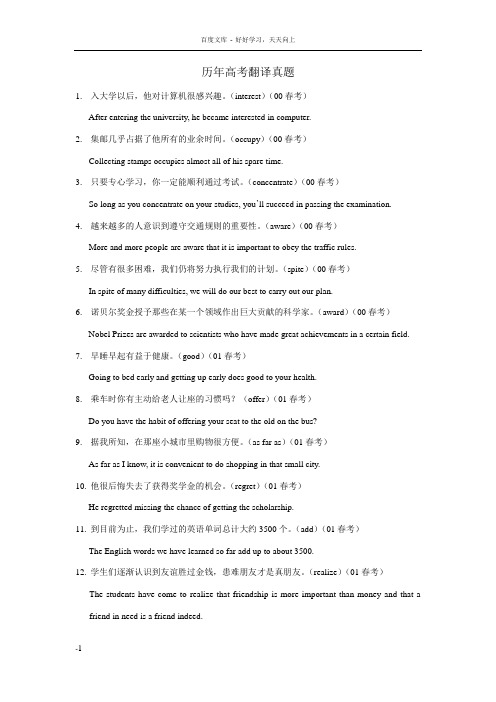
历年高考翻译真题1.入大学以后,他对计算机很感兴趣。
(interest)(00春考)After entering the university, he became interested in computer.2.集邮几乎占据了他所有的业余时间。
(occupy)(00春考)Collecting stamps occupies almost all of his spare time.3.只要专心学习,你一定能顺利通过考试。
(concentrate)(00春考)So long as you concentrate on your studies, you’ll succeed in passing the examination.4.越来越多的人意识到遵守交通规则的重要性。
(aware)(00春考)More and more people are aware that it is important to obey the traffic rules.5.尽管有很多困难,我们仍将努力执行我们的计划。
(spite)(00春考)In spite of many difficulties, we will do our best to carry out our plan.6.诺贝尔奖金授予那些在某一个领域作出巨大贡献的科学家。
(award)(00春考)Nobel Prizes are awarded to scientists who have made great achievements in a certain field. 7.早睡早起有益于健康。
(good)(01春考)Going to bed early and getting up early does good to your health.8.乘车时你有主动给老人让座的习惯吗?(offer)(01春考)Do you have the habit of offering your seat to the old on the bus?9.据我所知,在那座小城市里购物很方便。
大学英语六级历年翻译真题及答案.6
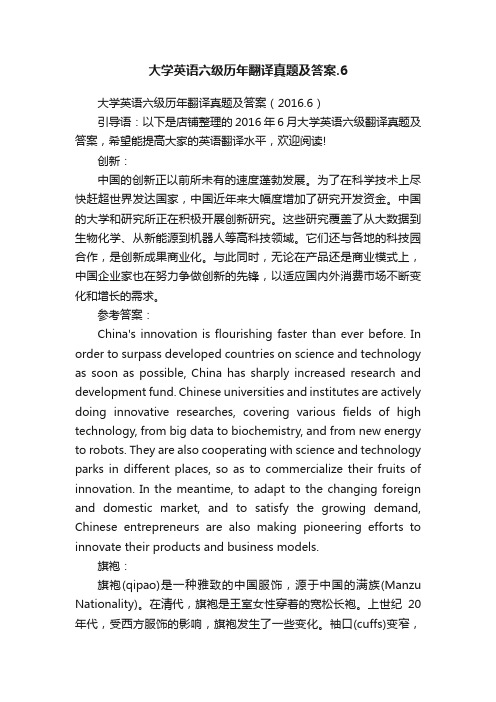
大学英语六级历年翻译真题及答案.6大学英语六级历年翻译真题及答案(2016.6)引导语:以下是店铺整理的2016年6月大学英语六级翻译真题及答案,希望能提高大家的英语翻译水平,欢迎阅读!创新:中国的创新正以前所未有的速度蓬勃发展。
为了在科学技术上尽快赶超世界发达国家,中国近年来大幅度增加了研究开发资金。
中国的大学和研究所正在积极开展创新研究。
这些研究覆盖了从大数据到生物化学、从新能源到机器人等高科技领域。
它们还与各地的科技园合作,是创新成果商业化。
与此同时,无论在产品还是商业模式上,中国企业家也在努力争做创新的先锋,以适应国内外消费市场不断变化和增长的需求。
参考答案:China's innovation is flourishing faster than ever before. In order to surpass developed countries on science and technology as soon as possible, China has sharply increased research and development fund. Chinese universities and institutes are actively doing innovative researches, covering various fields of high technology, from big data to biochemistry, and from new energy to robots. They are also cooperating with science and technology parks in different places, so as to commercialize their fruits of innovation. In the meantime, to adapt to the changing foreign and domestic market, and to satisfy the growing demand, Chinese entrepreneurs are also making pioneering efforts to innovate their products and business models.旗袍:旗袍(qipao)是一种雅致的中国服饰,源于中国的满族(Manzu Nationality)。
大学英语四级考试翻译真题与答案
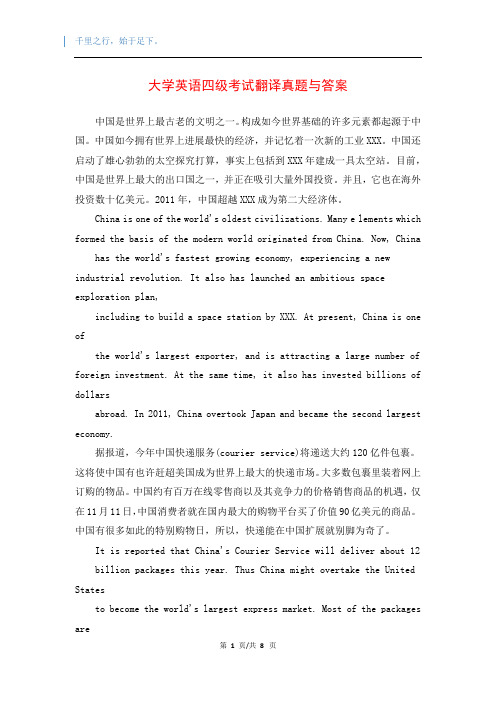
大学英语四级考试翻译真题与答案中国是世界上最古老的文明之一。
构成如今世界基础的许多元素都起源于中国。
中国如今拥有世界上进展最快的经济,并记忆着一次新的工业XXX。
中国还启动了雄心勃勃的太空探究打算,事实上包括到XXX年建成一具太空站。
目前,中国是世界上最大的出口国之一,并正在吸引大量外国投资。
并且,它也在海外投资数十亿美元。
2011年,中国超越XXX成为第二大经济体。
China is one of the world's oldest civilizations. Many e lements which formed the basis of the modern world originated from China. Now, China has the world's fastest growing economy, experiencing a new industrial revolution. It also has launched an ambitious space exploration plan,including to build a space station by XXX. At present, China is one ofthe world's largest exporter, and is attracting a large number of foreign investment. At the same time, it also has invested billions of dollarsabroad. In 2011, China overtook Japan and became the second largest economy.据报道,今年中国快递服务(courier service)将递送大约120亿件包裹。
文言翻译真题每日一练(2018-2021)

每日一练历年全国卷翻译真题(2021·新高考卷1)1.把文中画横线的句子翻译成现代汉语。
(1)上患吏多受赇,密使左右试赂之。
(4分)(2)君恶闻其过则忠化为佞,君乐闻直言则佞化为忠。
(4分)【参考答案】(1)皇上担心官吏中多有接受贿赂的,暗地里叫身边人贿赂官员进行试探。
(2)君主厌恶听到自己的过错,忠臣就会变为佞臣;君主喜爱听到正直的言论,佞臣就会变成忠臣。
注意以下关键词:(1)“患”,担心;“赇”,贿赂;“左右”,身边的人。
(2)“恶”,厌恶;“过”,过错;“佞”,佞臣。
(2021·新高考卷2)2.把文中画横线的句子翻译成现代汉语。
(1)逖不报书,而听其互市,收利十倍。
(4分)(2)知大功不遂,感激发病。
(4分)【参考答案】(1)祖逖没有答复这封信,而听凭双方民间互相贸易,收取十倍的利润。
(2)祖逖知道大功不能告成,情绪激动引发重病。
注意以下关键词:(1)报,答复;听,听凭;互市,互相贸易。
(2)遂,成;感激,情绪激动。
(2021·全国甲卷)3.把文中画横线的句子翻译成现代汉语。
(1)每纵游骑剽掠,小不利辄引去,徜徉无斗志。
(5分)(2)若欲货财,汉以玉帛赐单于,有故事,宜许之。
(5分)【参考答案】(1)常常纵使游动骑兵抢劫掠夺,稍稍失利就撤退,来回游荡没有斗志。
(2)如果想要货物钱财,汉朝曾赐给匈奴单于玉帛,有先例,应当答应他们。
注意以下关键词:(1)每:常常。
纵:纵容,纵使。
剽掠:抢劫掠夺。
小:稍微。
辄:总是,就。
引去:撤退。
徜徉:徘徊游荡。
(2)货财:货物钱财。
故事:先例,旧例。
宜:应该。
许:答应。
(2021·全国乙卷)4.把文中面横线的句子翻译成现代汉语。
(1)而既知其不可,复断之以法,此乃忍小忿而存大信也。
(5分)(2)皆令门下覆视,有据法当死而情可矜者,录状以闻。
(5分)【参考答案】(1)然而既然已经知道不可以这样,再依法裁决,这正是忍耐小的愤怒保全了大的信用啊。
2016年11月英语三级笔译真题及答案大师兄翻硕版

2016年11月英语三级笔译真题及答案大师兄翻硕版2016年5月和11月CATTI英语二三级笔译真题及大师兄版参考译文答案及历年CATTI英语二三级笔译真题及答案由大师兄翻硕整理。
2016年11月英语三级笔译真题汉译英节为“保利集团”简介。
此份真题难度不大,与2015年及2014年的同类真题难度接近,详见配套解析讲义。
2016年11月英语二级笔译真题及2017年版历年CATTI英语二级笔译和三级笔译陆续上传。
2016年11月全国翻译专业资格(水平)考试英语三级《笔译实务》试卷Section 1: English-Chinese Translation (50 points) Translate the following passage into Chinese.Harper Lee was an ordinary womanas stunned as anybody by the extraordinary success of “To Kill a Mockingbird.”“It was like being hit over thehead and kn ocked cold,” Lee — who died Friday at age89,saidduring a 1964 interview. “I didn’t expect the book to sell in the first place.I was hoping for a quick and merciful death at the hands of reviewers but atthe same time I sort of hoped that maybe someone would like it enough to giveme encouragement.”“To Kill a Mockingbird” may notbe the Great American Novel. But it’s likely the most universally known work offiction by an American author over the past 70 years. Lee was cited for hersubtle, graceful style and gift for explaining the world through a child’s eye,but the secret to the novel’s ongoing appeal was also in how many books thissingle book contained.“To Kill a Mockingbird” was a coming-of-age story, acourtroom thriller, a Southern novel, a period piece, a drama about class, and— of course — a drama of race.”All I want to be is the JaneAusten of South Alabama,” she once observed. The story of Lee is essentiallythe story of her book, and how she responded to it. She was a warm, vibrant andwitty woman who played golf, fished, ate at McDonald’s, fed ducks by tossingseed corn out of a Cool Whip tub, read voraciously, and got about to plays andconcerts. She just didn’t want to talk about it before an audience.“To Kill a Mockingbird” was aninstant and ongoing hit, published in 1960, as the civil rights movement wasaccelerating. It’s the story of a girl nicknamed Scout growing up in aDepression-era Southern town. A black man has been wrongly accused of raping awhite woman, and Scout’s fathe r, the resolute lawyer, defends him despitethreats and the scorn of many.Praised by The New Yorker as “skilled,unpretentious, and totally ingenious,” the bookwon the Pulitzer Prize and wasmade into a memorable movie in 1962.“Mockingbird” inspired ageneration of young lawyers and social workers, was assigned in high schoolsall over the country and was a popular choice for citywide, or nationwide,reading programs, although it was also occasionally removed from shelves forits racial content and references to rape.By 2015, sales topped 40 millioncopies.When the Library of Congress dida survey in 1991 on books that have affected people’s lives, “To Kill aMockingbird” was second only to the Bible.Lee herself became more elusive tothe public as her book became more famous. At first, she dutifully promoted herwork. She spoke frequently to the press, wrote about herself and gave speeches,once to a class of cadets at West Point.But she began declining interviews inthe mid-1960s and, until late in her life, firmly avoided making any publiccomment about her novel or her career.Her novel, while hugely popular,was not ranked by many scholars in the same category as the work of otherSouthern authors Decades after its publication, little was written about it inscholarly journals. Some critics have called the book naive and sentimental,whether dismissing the Ku Klux Klan as a minor nuisance in Maycomb oradvocating change through personal persuasion rather than collective action.Section 2: Chinese-English Translation (50 points) Translate the following passage into English.本公司是中国保利集团控股的大型国有房地产上市公司,国家一级房地产开发资质企业,连续五年荣膺中国房地产行业领导公司品牌。
历年大学英语六级真题及答案:翻译
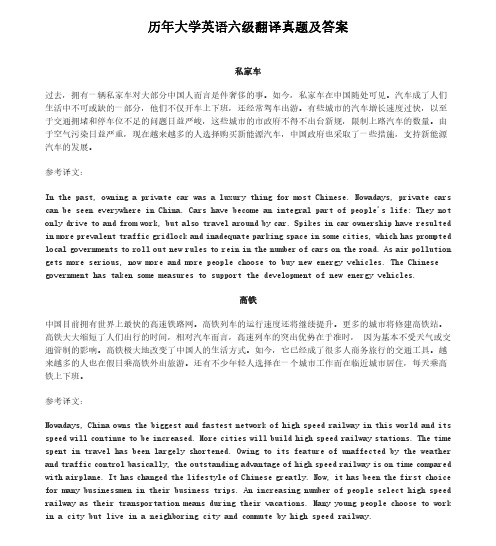
历年大学英语六级翻译真题及答案私家车过去,拥有一辆私家车对大部分中国人而言是件奢侈的事。
如今,私家车在中国随处可见。
汽车成了人们生活中不可或缺的一部分,他们不仅开车上下班,还经常驾车出游。
有些城市的汽车増长速度过快,以至于交通拥堵和停车位不足的问题日益严峻,这些城市的市政府不得不出台新规,限制上路汽车的数量。
由于空气污染日益严重,现在越来越多的人选择购买新能源汽车,中国政府也采取了一些措施,支持新能源汽车的发展。
参考译文:In the past,owning a private car was a luxury thing for most Chinese.Nowadays,private cars can be seen everywhere in China.Cars have become an integral part of people's life:They not only drive to and from work,but also travel around by car.Spikes in car ownership have resulted in more prevalent traffic gridlock and inadequate parking space in some cities,which has prompted local governments to roll out new rules to rein in the number of cars on the road.As air pollution gets more serious,now more and more people choose to buy new energy vehicles.The Chinese government has taken some measures to support the development of new energy vehicles.高铁中国目前拥有世界上最快的高速铁路网。
大学英语四级翻译真题
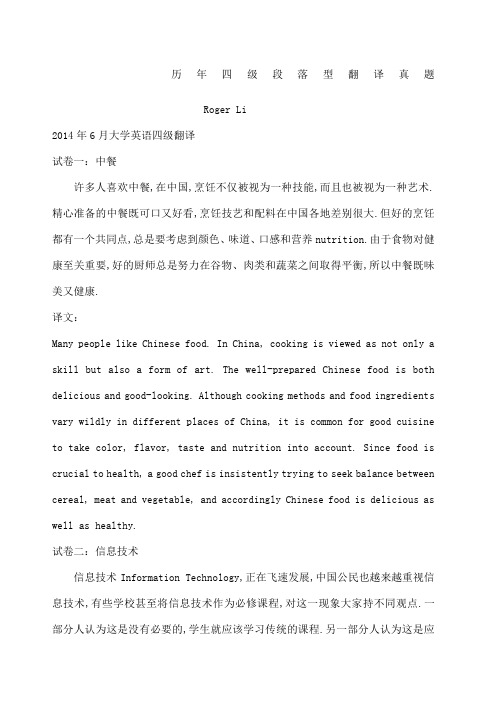
历年四级段落型翻译真题Roger Li2014年6月大学英语四级翻译试卷一:中餐许多人喜欢中餐,在中国,烹饪不仅被视为一种技能,而且也被视为一种艺术.精心准备的中餐既可口又好看,烹饪技艺和配料在中国各地差别很大.但好的烹饪都有一个共同点,总是要考虑到颜色、味道、口感和营养nutrition.由于食物对健康至关重要,好的厨师总是努力在谷物、肉类和蔬菜之间取得平衡,所以中餐既味美又健康.译文:Many people like Chinese food. In China, cooking is viewed as not only a skill but also a form of art. The well-prepared Chinese food is both delicious and good-looking. Although cooking methods and food ingredients vary wildly in different places of China, it is common for good cuisine to take color, flavor, taste and nutrition into account. Since food is crucial to health, a good chef is insistently trying to seek balance between cereal, meat and vegetable, and accordingly Chinese food is delicious as well as healthy.试卷二:信息技术信息技术Information Technology,正在飞速发展,中国公民也越来越重视信息技术,有些学校甚至将信息技术作为必修课程,对这一现象大家持不同观点.一部分人认为这是没有必要的,学生就应该学习传统的课程.另一部分人认为这是应该的,中国就应该与时俱进.不管怎样,信息技术引起广大人民的重视是一件好事.译文:As Chinese citizens are attaching increasing importance to the rapidly developing Information Technology, some colleges even set it as a compulsory course. In regard to this, people hold different opinions. Some people view it as unnecessary move, for students should learn the traditional curriculum. Other thinks it is a need, because China should keep pace with the times. Anyway, it is a good thing that Information Technology arouses public concern.试卷三:茶文化"你要茶还是咖啡"是用餐人常被问到的问题,许多西方人会选咖啡,而中国人则会选茶,相传,中国的一位帝王于五千年前发现了茶,并用来治病,在明清the qing dynasties期间,茶馆遍布全国,饮茶在六世纪传到日本,但直到18世纪才传到欧美,如今,茶是世界上最流行的饮料beverage之一,茶是中国的瑰宝.也是中国传统和文化的重要组成部分.译文:"Would you like tea or coffee" That’s a question people often asked when having meal. Most westerners would choose coffee, while the Chinese would like to choose tea. According to legend, tea was discovered by a Chinese emperor five thousand years ago, and then was used to cure disease. During the Ming and Qing dynasties, tea houses were all over the country. Tea drinking spread to Japan in the 6th century, but it was not until the 18thcentury does it spread to Europe and America. Nowadays, tea is one of the most popular beverages in the world, and it is not only the treasure of China but also an important part of Chinese tradition and culture.试卷四:中国结中国结最初是由手工艺人发明的,经过数百年不断的改进,已经成为一种优雅多彩的艺术和工艺.在古代,人们用它来记录事件,但现在主要是用于装饰的目的.“结”在中文里意味着爱情,婚姻和团聚,中国结常常作为礼物交换或作为饰品祈求好运和辟邪.这种形式的手工艺代代相传,现在已经在中国和世界各地越来越受欢迎.译文:Chinese knot was originally invented by the craftsmen. Through hundreds of years of continuous improvement,it has become a kind of elegant and colorful arts and crafts. In the ancient times,people used it to record things,but now it was mainly used as ornaments. In Chinese, the knot means love, marriage and reunion, and is often used for gift exchange or praying for good luck and warding off evil spirits. This form of handicrafts passes down from generation to generation, and then it has become increasingly popular in China and around the world.英语六级试卷一:中秋节中国人自古以来就在中秋时节庆祝丰收,这与北美地区庆祝感恩节的习俗十分相似,过中秋节的习俗与唐代早期在中国各地开始流行,中秋节在农历八月十五,是人们拜月的节日,这天夜晚皓月当空,人们合家团聚,共赏明月.2006年,中秋节被列为中国的文化遗产,2008年又被定为公共假日,月饼被视为中秋节不可或缺的美食,人们将月饼作为礼物馈赠亲友或在家庭聚会上享用.传统的月饼上带有“寿”longevity、“福”或“和”等字样.译文:Ever since ancient times, the Chinese usually celebrate harvest in the Mid-Autumn, which is similar to the custom of celebrating Thanksgiving in the North America. The tradition of celebrating Mid-Autumn festival became popular throughout China in the early Tang dynasty. The lunar August 15 is a day for people worshiping the moon. On this day, under the dazzling bright moon, families reunite and enjoy the moon’s beauty. In 2006, Mid-Autumn festival was listed as one of China's cultural heritage, and in 2008, it was classified as a public holiday. Moon cakes, as indispensable delicious food of the festival, were gifts people sent to families and friends during the festival and usually enjoyed on family gatherings. There are characters of “longevity”,“good fortune”and “harmony” on the traditional moon cakes.试卷二:丝绸之路闻名于世的丝绸之路是一系列连接东西方的路线.丝绸之路延伸6,000多公里.得名于古代中国的丝绸贸易.丝绸之路上的贸易在中国、南亚、欧洲和中东文明发展中发挥了重要作用.正是通过丝绸之路,中国的造纸、火药、指南针、印刷等四大发明才被引介到世界各地.同样,中国的丝绸、茶叶和瓷器porcelain也传遍全球.物质文化的交流是双向的.欧洲也通过丝绸之路出口各种商品和植物,满足中国市场的需要.译文:The world-renowned Silk Road is a series of routes connecting the East and the West. It extends more than 6,000 kilometers. The Silk Road was named after ancient China’s silk trade which played an important role in the civilization development of China, South Asia, Europe and the Middle East. It was through the Silk Road that papermaking, gunpowder, compass and printing of the four great inventions of ancient China were introduced to places around the world. Similarly, Chinese silk, tea and porcelain spread all over the world. Europe also exported various goods and plants through the Silk Road to meet the needs of the Chinese market.试卷三:中国园林中国园林是经过三千多年演化而成的独具一格的园林景观.它既包括为皇室成员享乐而建造的大型花园,也包括学者、商人和卸任的政府官员为摆脱嘈杂的外部世界而建造的私家花园.这些花园构成了一种意在表达人与自然之间应有的调和关系的微缩景观.典型的中国园林周围有围墙,园内有池塘、假山、树木、花草以及各种各样由弯曲的小路和走廊衔接的建筑.散步在花园中,人们可以看到一系列精心设计的景观犹如山水画卷一般展示在面前.译文:Through three thousand years of evolution, Chinese garden exhibits its unique landscape. It includes not only the large garden built for the royalfamily enjoyment, but also private garden built by academics, businessmen, and former government officials to retreat from the noise of the outside world. These gardens constitute miniature landscape intended to express the harmonious relations between human and nature. Enclosed by fence, a typical Chinese garden has ponds, rockeries, trees, flowers and plants, and various buildings connected by winding paths and corridors. Stroll in the garden, a series of carefully designed landscape unfolding in front of you like landscape scroll2014年6月大学英语四级翻译试卷一:教育公平:为了促进教育公平,中国已经投入360亿元,用于改善农村地区教育设施和加强中西部地区农村义务教育.这些资金用于改善教学设施、购买书籍,使16万多所中小学收益.资金还用于购置音乐和绘画器材.现在农村和山区的儿童可以与沿海城市的儿童一样上音乐和绘画课.一些为接受更好教育而转往城市上学的学生如今又回到了本地农村学校就读.译文:In order to promote education equality, China has invested 36 billion yuan to improve the educational facilities in rural areas and enhance the rural compulsory education in the midwest. The fund is used to upgrade teaching facilities and to purchase books, benefiting more than 160 thousand primary schools and middle schools. Meanwhile, the fund is used to buy musical instruments and painting supplies. Now, like the childrenin coastal cities, those living in rural and mountain areas also have music and painting lessons. As a result, some students, once transferring to other cities for better education, come back to local schools now.试卷二阅读中国的教育工作者早就认识到读书对于国家的意义.有些教育工作者2003年就建议设立全民读书日.他们强调,人们应当读好书,尤其是经典着作.通过阅读,人们能更好的学会感恩、有责任心和与人合作,而教育的目的正是要培养这些基本素质.阅读对于中小学生尤为重要,假如他们没有在这个关键时期培养阅读的兴趣,以后要培养成阅读的习惯就跟难了.译文:Chinese education workers have long realized the significance of reading for a nation. In 2003 some workers suggested that we should have a national reading day. They proclaimed that people should read good books especially the classical ones. Reading enables people to learn how to be grateful, responsible and cooperative. The real goal of education is to cultivate these basic personalities. Reading is particularly important for middle and primary school students. Suppose they don't cultivate the interest in reading at that key moment, it will be harder to develop a habit to read books.试卷三核能中国进一步发展核能,因为核电目前只占其总发电量的2%.该比例在所有核国家中居第30位,几乎是最低的.2011年3月日本核电站事故后,中国的核能开发停了下来,中止审批新的核电站,并开展全国性的核安全检查.到2012年10月,审批才又谨慎地恢复.随着技术和安全措施的改进,发生事故的可能性完全可以降低到最低程度.换句话说,核能是可以安全开发和利用的.译文:China should further develop the nuclear energy, for nuclear power only accounts for 2% of the gross electrical power output, which rank China the 30th, the lowest in the list of countries which own nuclear power.After the Japan's accidents in March 2011, the exploration of nuclear power has been suspended, including halting the examining and approving new nuclear power stations as well as safety inspection of all the nuclear stations in the country. The approval didn't recover until October, 2012. With the improvement in technology and safety, the possibilities of nuclear accidents could be reduced to the minimum degree. That is to say, nuclear power could be developed and utilized without accidents.2014年12月大学英语四级翻译试卷一:旅游越来越多的中国年轻人正对旅游产生兴趣,这是近年来的新趋势.年轻游客数量的不断增加,可以归因于他们迅速提高的收入和探索外部世界的好奇心.随着旅行多了,年轻人在大城市和着名景点花的时间少了,他们反而更为偏远的地方所吸引.有些人甚至选择长途背包旅行.最近调查显示,很多年轻人想要通过旅行体验不同的文化、丰富知识、拓宽视野.译文:The young Chinese are showing interest in traveling, which is a new trend recently. The increasing number of young travelers can be attributed to the rapid growth of income and the curiosity to explore the outside world. As they travel more, youngsters spend more time in remote areas rather than big cities or well-known place of interest. Furthermore, some of them even choose backpacking. Recent survey shows that many young people wish to experience different culture, enrich knowledge, and broaden their horizon through traveling.试卷二:大熊猫大熊猫是一种温顺的动物,长着独特的黑白皮毛.因其数量稀少,大熊猫已被列为濒危物种.大熊猫对于世界自然基金会有着特殊的意义.自 1961 年该基金会成立以来,大熊猫就一直是它的徽标. 大熊猫是熊科中最稀有的成员, 主要生活在中国西南部的森林里.目前,世界上大约有 1000 只大熊猫.这些以竹为食的动物正面临许多威胁.因此,确保大熊猫的生存比以往更重要.译文:Panda is a kind of gentle animal with a black-and-white coat. It has been listed as an endangered animal due to its very limited number. The giant panda is of special significance to WWF World Wild Fund for Nature. Since its establishment in 1961, panda has been its symbol. The giant panda is the rarest animal of the bears, mainly living in the forests in south westof China. Now, there are approximately 1,000 giant pandas. The animal that mainly feeds on bamboo is facing many threats. Therefore, to ensure its safety is of greater importance than ever before.翻译三:互联网中国的互联网社区是全世界发展最快的,2010年,中国约有亿网民,而且人数还在迅速增长.互联网的日渐流行带来了重大的社会变化.中国网民往往不同于美国网民.美国网民更多的是受实际需要的驱使,用互联网为工具发电子邮件、买卖商品、做研究、规划旅程或付款.中国网民更多是出于社交原因使用互联网,因而更广泛的使用论坛、博客、聊天室等等.译文:The Chinese Internet communities saw the fastest development with about 420 million netizens in 2010 and this numbers keeps increasing rapidly. The growing popularity of the Internet brings about tremendous social changes. Chinese netizens differ from their American counterparts. The latter is more motivated by real needs. They use Internet as tools of sending emails, purchasing goods, doing research, planning tours or making payments. Chinese netizens use Internet for social reasons. Therefore, things like Internet forums, blogs and chat rooms etc. are more widely used.2015年6月四级翻译试题一:中国元素中国是世界上最古老的文明之一.构成现在世界基础的许多元素都起源于中国.中国现在拥有世界上发展最快的经济,并经历着一次新的工业革命.中国还启动了雄心勃勃的太空探索计划,其实包括到2020年建成一个太空站.目前,中国是世界上最大的出口国之一,并正在吸引大量外国投资.同时,它也在海外投资数十亿美元.2011年,中国超越日本成为第二大经济体.译文 :China is one of the most ancient cultures in the world. Many elements that construct the foundation of the modern world are derived from China. While witnessing the fastest development of its economy, China is, now, experiencing a new industrial revolution. Also, China has initiated an ambitious program to explore the outer space, including to complete a space station by 2020. Currently, being one of the largest exporters in the world, China is attracting massive foreign investment. Meanwhile, it has invested billions of dollars overseas. In 2011, China surpassed Japan as the world’s second-largest economy.试题二:情绪那些保持适应性情绪控制状态的人,把逆境看作是暂时性的,相信困难应该会过去的.在一项危机中,他们很好地调整自己,坚信控制来源于激励的行动而非控制反应.他们不会受到紧张或痛苦情绪的惊吓;他们采取有效的应对策略,例如取得亲朋的支持和自我的述说.研究表明那些拥有高情商的人处理创伤性traumatic 事件时很少会有负面心理问题.译文:Those who maintain an adaptive state of emotional control viewadversity as temporary and hold the belief that “This shall pass.” In a crisis, they are able to adjust themselves well and firmly believe that the control comes from inspired action rather than controlled reaction. They are not scared by intense or painful emotions; they employ effective coping strategies, such as obtaining support from relatives and friends, and self-talk. The study indicates that individuals with a high emotional intelligence handle traumatic events with rare negative psychological problems.试题三:大米在西方人心目中,和中国关系最为密切的基本食物是大米.长期以来,大米在中国人的饮食中占据很重要的地位,以至于有谚语说“巧妇难为无米之炊”.中国南方大多种植水稻.人们通常以大米为主食:而华北大部分地区因为过于寒冷或过于干燥,无法种植水稻,那里的主要作物是小麦.在中国,有些人用面粉做面包,但大多数人用面粉做馒头和面条.译文:译文:In the eyes of Westerners, the basic food that has the most to do with China is rice. For a long time, rice occupies such an important position in Chinese people's diet that proverb says "One can’t make bricks without straw", In South China, the mostly cultivated crop is rice, and it is usually taken as the staple; whereas; whereas, in most of North China, it is too cold and dry to grow rice, where the main crop is wheat. In China, somepeople make bread with flour, but most people make bread and noodles with flour.。
翻译讲解和上海历年翻译真题
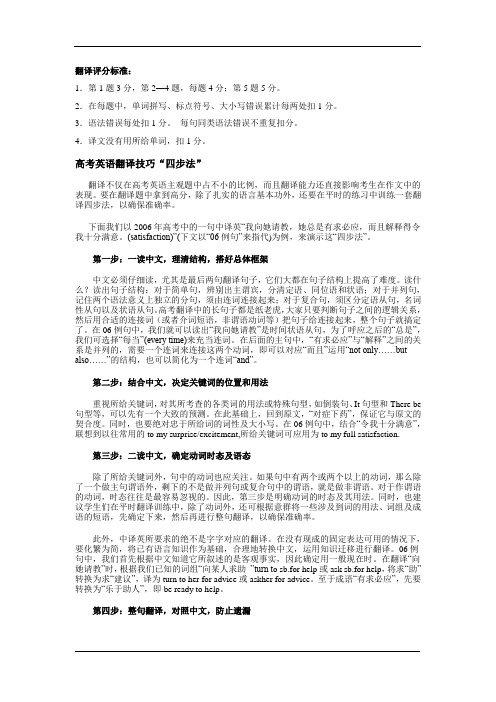
翻译评分标准:1.第1题3分,第2—4题,每题4分;第5题5分。
2.在每题中,单词拼写、标点符号、大小写错误累计每两处扣1分。
3.语法错误每处扣1分。
每句同类语法错误不重复扣分。
4.译文没有用所给单词,扣1分。
高考英语翻译技巧“四步法”翻译不仅在高考英语主观题中占不小的比例,而且翻译能力还直接影响考生在作文中的表现。
要在翻译题中拿到高分,除了扎实的语言基本功外,还要在平时的练习中训练一套翻译四步法,以确保准确率。
下面我们以2006年高考中的一句中译英―我向她请教,她总是有求必应,而且解释得令我十分满意。
(satisfaction)‖(下文以―06例句‖来指代)为例,来演示这―四步法‖。
第一步:一读中文,理清结构,搭好总体框架中文必须仔细读,尤其是最后两句翻译句子,它们大都在句子结构上提高了难度。
读什么?读出句子结构:对于简单句,辨别出主谓宾,分清定语、同位语和状语;对于并列句,记住两个语法意义上独立的分句,须由连词连接起来;对于复合句,须区分定语从句,名词性从句以及状语从句。
高考翻译中的长句子都是纸老虎,大家只要判断句子之间的逻辑关系,然后用合适的连接词(或者介词短语,非谓语动词等)把句子给连接起来,整个句子就搞定了。
在06例句中,我们就可以读出―我向她请教‖是时间状语从句,为了呼应之后的―总是‖,我们可选择―每当‖(every time)来充当连词。
在后面的主句中,―有求必应‖与―解释‖之间的关系是并列的,需要一个连词来连接这两个动词,即可以对应―而且‖运用―not only……but also……‖的结构,也可以简化为一个连词―and‖。
第二步:结合中文,决定关键词的位置和用法重视所给关键词,对其所考查的各类词的用法或特殊句型,如倒装句、It句型和There be 句型等,可以先有一个大致的预测。
在此基础上,回到原文,―对症下药‖,保证它与原文的契合度。
同时,也要绝对忠于所给词的词性及大小写。
山东师范大学翻译硕士考研真题

山东师范大学翻译硕士考研真题山东师范大学(回忆)翻译硕士英语一、30个单选题,前15个是词汇题,是划出某个生僻词,然后从四个选项中选取同义词,后15个是语法题,比专四水平略高。
二、4篇阅读理解:第一篇关于美国细胞研究减速对国家的影响。
第二篇是对某作家写的地中海历史一书的批评。
第三篇是美国银行业性质的转变以及对美国消费的批评。
(这三篇都是单选题,一篇5个。
)第四篇是主观题,是关于现代人对于工作的失望,总体难度与专八差不多。
三、作文,400词,the essence of happiness.英语翻译基础一、15个英译汉的短语术语:demographic statistics人口统计学stamp duty印花税ozone layer臭氧层war correspondent战地记者Byzantine art拜占庭艺术energy conservation能源节约,能源守恒international protocol国际协定job intermediary职位中介interlingual translation语际翻译game theory博弈论functional equivalence功能对等二、15个汉翻英的短语术语:谅解备忘录Memorandum of Understanding领土完整territorial integrity养老基金pension fund国际惯例international usage/international common practice急救站first-aid station反倾销anti-dumping原油crude oil记者招待会press conference房地产real estate勇于创新be brave in making innovations分期付款installment贸易技术壁垒technical barriers to trade(TBT)二、短文英译汉,汉译英。
英语翻译基础历年真题试卷汇编90(题后含答案及解析)

英语翻译基础历年真题试卷汇编90(题后含答案及解析)全部题型 2. 英汉互译英汉互译英译汉1.Global financial stability has improved over the past six months, bolstered by better macroeco-nomic performance and continued accommodative macroeconomic policies, but fragilities remain. The two-speed recovery—modest in advanced economies and robust in emerging market economies—has posed different policy challenges for countries. In advanced economies hit hardest by the crisis, governments and households remain heavily indebted, to varying degrees, and the health of financial institutions has not recovered in tandem with the overall economy. Emerging market economies are facing new challenges associated with strong domestic demand, rapid credit growth, relatively accommodative macroeconomic policies, and large capital inflows. Geopolitical risks could also threaten the economic and financial outlook, with oil prices increasing sharply amid fears of supply disruptions in the Middle East and North Africa. The main task facing policymakers in advanced economies is to shift the balance of policies a-way from reliance on macroeconomic and liquidity support to more structural policies—less “leaning”and more “cleaning”of the financial system. This will entail reducing leverage and restoring market discipline, while avoiding financial or economic disruption during the transition. Thus, ongoing policy efforts to withdraw (implicit) public guarantees and ensure bondholder liability for future losses must build on more rapid progress toward stronger bank balance sheets, ensuring medium-term fiscal sustainability and addressing excessive debt burdens in the private sector. For policymakers in emerging market economies, the task is to limit overheating and a buildup of vulnerabilities—to avoid “cleaning”later. Emerging market economies have continued to benefit from strong growth relative to that in advanced economies, accompanied by increasing portfolio capital inflows. This is putting pressure on some financial markets, contributing to higher leverage, potential asset price bubbles, and inflationary pressures. Policymakers will have to pay increasing attention to containing the buildup of macro-financial risks to avoid future problems that could inhibit their growth and damage financial stability. In a number of cases, this will entail a tighter macroeconomic policy stance, and, when needed, the use of macro-prudential tools to ensure financial stability. Increasing the financial sector’s capacity to absorb higher flows through efforts to broaden and deepen local capital markets will also help.正确答案:六个月来,在宏观经济业绩改善和宏观经济政策持续宽松的支持下,全球金融稳定形势有所好转,但脆弱性仍然存在。
00600高级英语2017-2022历年翻译真题(附答案)

202204(上Lesson 12)57.它注定是失败的,每一本书都是失败的,但我确实清楚地知道我想写什么样的书。
It is bound to be a failure, every book is a failure, but l do know with some clarity what kind of book I want to write.(下Lesson 8)58.多年来,我一直搞不清楚蔬菜到底出了什么问题。
我当然知道,大多数蔬菜要想享用它们最鲜美的味道。
必须新鲜采摘并且立即烹调。
For years, I couldn’t figure out what had happened to vegetables. I knew, of course, that most vegetables, to be enjoyed in their full deliciousness, must be picked fresh and cooked at once.(下Lesson 10)59.对于这些产品领先者来说,竞争并非有关产品价格或客户服务(尽管它们不能被忽视),而是有关产品性能。
For these product leaders, competition is not about price or customer service ( though those can’t be ignored ), it’s about product performance(性能).(下Lesson 4)60.晚年生活中获得满足乃至成就的潜能是真实存在而未被充分开发的。
大体上,老年人都是在一个冷漠的世界里挣扎着生存。
The potentials for satisfactions and even triumphs in late life are real and vastly underexplored. For the most part the elderly struggle to exist in an inhospitable world.(上Lesson 13)61.你杀死了你的敌人,而当他死了,你的职业便不复存在,你从胜利中获得的满足感也会很快消退。
- 1、下载文档前请自行甄别文档内容的完整性,平台不提供额外的编辑、内容补充、找答案等附加服务。
- 2、"仅部分预览"的文档,不可在线预览部分如存在完整性等问题,可反馈申请退款(可完整预览的文档不适用该条件!)。
- 3、如文档侵犯您的权益,请联系客服反馈,我们会尽快为您处理(人工客服工作时间:9:00-18:30)。
2012英语翻译基础第一项:术语解释,20分,5个1.G202.经济适应房3.和而不同4.工业“三废”5.保障性住房问答题:用自己的话说说翻译中对待source text要注意哪些factors 10分What factors do u think should be taken into consideration in translating a source text第二项:汉译英 60分统筹战时医学教育的问题抗日战争是一场全民族的战争。
全国人民,不论男女,不论老少,不论南北,都有保卫国土的责任。
抗战是涉及到多方面的因素,其中医疗救治是一个重要部分。
不论是前方在战场上浴血奋战的战士,还是流离失所的难民和无家可归的群众,他们都需要药品,防疫等。
抗战中的医学教育机构也要承担很多责任。
有些学校对抗战很热,把所有的教授,学生和设备都运到前线和大后方的医院,以至于学校处于停顿状体。
有些学校为了保存实力,从甲地移往乙地,从乙地移往丙地,以致于大部分老师和学生都几乎成为逃难的难民,所经受的艰苦不言自明。
有的学校很不负责任,依旧照常运行,丝毫不受战争的影响,这些学校对国家一点都负责任。
战时需要大量的医护人员,而原本就紧缺的医护人员远不能满足战争的紧急需要,医学教育机构和学院要在最短的时间内培养出大批医护人员。
1938年12月,颜福庆在《中华医学杂志》上发表了“战时医学教育问题”,这篇文章为当时的医学教育政策做了纲领性的阐述。
颜福庆指出:“战时的医学教育问题是一个非常重要的问题,应该做统筹规划,但是政府却没有这么做。
医学教育机构也有责任培养医护人员。
一方面,医学教育机构要注重正常的教学和运行,另一方面,他们必须承担对国家的责任。
此处省略百余字。
(颜福庆是当时医学界的主要人物,复旦大学的这篇文章像是品论他的贡献)第三项:英译汉60分The Tell-Tale Heart(Edgar Allan Poe)2013英语翻译基础第一题,共4个词汇,共20分1、文化软实力cultural soft power2、文化自觉cultural consciousness3、贴近群众、贴近生活、贴近实际4、《食品安全法》food safety law.5、《反不当竞争法》anti-unfair competition law第二题,问答,10分what do you think of the statement that defferent styles of texts call for defferent approaches to translate?对于不同风格的文体要采取不同的翻译技巧,你如何认为?我自己写了翻译的过程是什么,understanding ,expressing,checking,然后说明在翻译过程中对于文体的确定是很重要的。
因为必须首先确定文体,然后才可以选择适当的单词,句子,等等然后较为详细的列举了legal translation 和civil engineering translation需要注意的问题.然后又说了literature translation 和business translation 等等需要不同的译法和风格。
第三题,翻译汉译英:讲的是人力资源服务业和十八大之间的种种关系。
讲到了服务业的作用,以及十八大、十二五规划对人力资源的促进作用。
英译汉:Every family has its own holiday traditions. In the Brown household, Christmas was always a time of delicious food, sing-alongs, colorful gifts, and mysterious codes.Yes, codes.When I was a kid, no Christmas morning was complete without the annual treasure hunt. When the last present under the Christmas tree had been opened, my siblings and I knew that there still remained one "big" present hidden somewhere in the house for us to find. Our only hope of locating it was a cryptic clue that traditionally resided in a lone envelope perched high on the tree, out of our reach.One year the envelope contained a particularly mind-boggling treasure hunt that my brother, sister and I still recall as The "TOCEP" Christmas Mystery. (In fact, this treasure hunt directly inspired the scene on page 111 of The Da Vinci Code.) That was the year we had a foreign exchange student living with us. Bea was South African and understandably was somewhat overwhelmed by the frenzied anticipation that led up to an American Christmas. Nonetheless, she embraced the decorating, singing, and cooking with a zeal that made the holidays doubly special for us that year. So it was with great happiness, on Christmas morning, after all the presents were opened, that my parents handed Bea the mysterious envelope and explained to her the Brown tradition of a Christmas Quest.Looking amazed that such a tradition could exist, Bea excitedly opened the envelope. The poem inside announced that this year's quest involved locating five letters of the alphabet, which had been hidden around the house. According to the poem’s final stanza, the first letter we needed to find was "T."You seek a letter in a nook(It's very hard to see).But of the places you might look,There’s just one spot for "T."Only one spot for T?My little brother Greg was the first to figure it out. He leapt up and dashed into the kitchen. We all ran after him as he retrieved a stool, dragged it into the breakfast nook, climbed up onto the counter, and grabbed the canister in which my mother kept her tea bags. Sure enough, inside was a note card emblazoned with theletter "T."Brilliant!Along with the letter "T" we found another clue, which ingeniously guided us down to the basement where we found the letter "O" taped to an O-shaped Hoola Hoop.Again, fiendishly clever!From there more clues led us all over the house. In the kitchen we found the letter "C" stuffed in a Vitamin C container. In the mud-room, the letter "E" was hidden inside my Exeter baseball cap (bearing that same letter).By then, we had located four letters (T-O-C-E), and still we felt no closer to understanding our mysterious prize. We hoped the fifth and final letter would make it all come clear. The final clue, however, was baffling.The final letter in your quest,Is simple as can be.It's hidden in a special roomQuite natural for a "P."A special room quite natural for a P?I looked in the pantry around the canned peas. Nothing.My little brother checked his bedroom for his Phillies cap. Nothing.A natural place for "P"?It was Beatrice, our exchange student (having learned a good amount of American slang), who suddenly gasped, jumped to her feet, and dashed up the stairs. For a moment, my siblings and I thought she was ill... but then we heard her shriek with joy. We raced upstairs to find Bea in the bathroom, laughing hysterically and pointing into the toilet. We peered inside, and there, to our enormous delight, we found the letter "P" taped inside the toilet bowl."P" in the toilet!The joke left all four of us kids rolling on the floor in hysterics. Surely my parents had to be the two funniest people alive. Finally, when we all could breathe again, we hurried back to the living room to decipher the meaning of these five mysterious lettersT-O-C-E-P?We spread the letters out on the living room floor and stared at them.T...O...C...E...P?They meant nothing to us.It was my younger sister Valerie who saw it first. She drew a startled breath and spun to my parents in disbelief. "No!" she exclaimed. "Really?"My parents were beaming. "Really. We leave tomorrow morning."The rest of us kids watched in rapt animation as little Valerie victoriously rearranged the five letters TOCEP.... to spell one magical word: EPCOT. Instantly, all four kids were dancing around the room, whooping for joy, chanting "Epcot! Epcot!" Even our exchange student Bea had heard of Walt Disney World's Epcot Center, and she joined in the dance. It was a dream come true. The very next morning, we all boarded a plane for Epcot.It was the best Christmas ever.2014英语翻译基础1.中国梦2.立党为公,执政为民3.世情、国情、党情4.PRISM英译汉:Introduction: The Cooling of the SoupIn the Department of Manuscripts at the British Library is a sheet of geometrical notes by Leonardo da Vinci.It is one of his last pieces of writing: it probably dates from 1518, the year before he died. The paper is adingy grey but the ink remains clear. There are some diagrams, and beside them a neatly blocked text writtenin his habitual, right-to-left ‘mirror-script’. It is not, on the face of it, one of Leonardo’s most exciting manuscripts, unless you happen to be an aficionado of Renaissance geometry. But it repays attention: it has a little twist in its tail. Three-quarters of the way d own the page the text breaks off with an abrupt ‘etcetera’. The last line looks like part of the theorem – the handwriting has hardly wavered at all –but what it actually says is ‘perche la minesstra si fredda’. He has left off writing ‘because the soup is getting cold’.There are other small nuggets of domestic detail in Leonardo’s manuscripts, but this is the one I like best. It is not that it tells us a great deal: that Leonardo ate a bowl of lukewarm soup on a day in 1518 hardly qualifies as an important piece of biographical data. What seems to make it special is a quality of surprise, of casualness. Into the dry abstractions of his geometrical studies has intruded this moment of simple, daily humanity. One sees an old man at a table, intently writing. In another room one sees a bowl of soup, intently steaming. Probably it is vegetable soup, for in later life Leonardo was a vegetarian. Probably it has been cooked by his serving-woman, Mathurine, to whom he would soon bequeath a ‘coat of fine black cloth lined with fur’ in recognition of her ‘good service’.2 Is it she who calls to Leonardo da Vinci to tell him his soup is getting cold? He continues to write for a few moments longer –the time it takes to write ‘perche la minesstra sifredda’ – and then he puts down his pen.There is also a hint of foreboding. As far as one can tell he never did return to these notes, and so this minor interruption seems to foreshadow the more definitive one soon to come. We might call this undistinguishedlooking page ‘Leonardo’s last theorem’–yet another unfinished project. The great enterprise of inquiry and exposition to which he has devoted his life tails off with this throwaway joke, this one-liner about the imperatives of dinner-time.For the biographer, such glimpses behind the scenes are heartening. Leonardo was an extraordinary man, but his life constantly intersected with ordinariness, and it is perhaps at those points of intersection that the biographer – that emissary sent out from the ordinary world –can make some kind of contact with him. There are all those complexities and profundities and world-famous paintings to grapple with, all those things that make Leonardo uniquely Leonardo, but here at least he is, for amoment, someone much like the rest of us.The Eagleby Alfred,Lord TennysonHe clasps the crag with crooked hands;Close to the sun in longly lands,Ringed with the azure world,he stands.The wrinkled sea beneath him crawls:He watches from his mountain wall,And like a thunderblot he falls.它有钩的双爪紧紧抓着羼岩在荒凉之地与太阳为伴万里碧空绕着他周环它从高高的山墙上傲然俯视死盯着大海蠕动的神逸陡飞下来迅疾似霹雳2015英语翻译基础(第一问):说出几个翻译方法与策略并加以比较(第二问):写出你认为国内五个比较有代表性的翻译家及其作品汉译英:关于随着人民生活水平提高,对生态环境的要求更高了,中国也在采取一系列措施建设生态文明。
